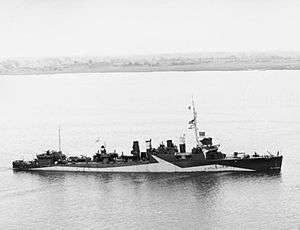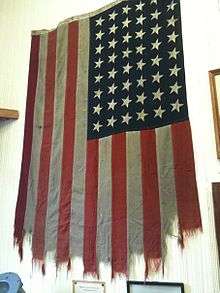USS Herndon (DD-198)
 HMS Churchill, underway, leaving a US Navy yard. | |
| History | |
|---|---|
| Name: | USS Herndon |
| Namesake: | William Lewis Herndon |
| Builder: | Newport News Shipbuilding & Dry Dock Company |
| Laid down: | 25 November 1918 |
| Launched: | 31 May 1919 |
| Commissioned: | 14 September 1920 |
| Decommissioned: | 6 June 1922 |
| Fate: | Transferred to USCG, 1930 |
| Acquired: | 13 September 1930 |
| Commissioned: | 7 March 1931 |
| Decommissioned: | 28 May 1934 |
| Fate: | Returned to Navy, 1934 |
| Acquired: | 1934 |
| Commissioned: | 4 December 1939 |
| Decommissioned: | 9 September 1940 |
| Struck: | 8 January 1941 |
| Fate: | Transferred to UK, 9 September 1940 |
| Name: | HMS Churchill |
| Acquired: | 9 September 1940 |
| Commissioned: | 9 September 1940 |
| Identification: | Pennant number: I45 |
| Fate: | Transferred to USSR, 16 July 1944 |
| Name: | Deyatelny |
| Acquired: | 16 July 1944 |
| Fate: | Sunk in action, 16 January 1945 |
| General characteristics | |
| Class and type: | Clemson-class destroyer |
| Displacement: | 1,190 long tons (1,210 t) |
| Length: | 314 long tons (319 t) |
| Beam: | 31 ft 9 in (9.68 m) |
| Draft: | 9 ft 4 in (2.84 m) |
| Installed power: | 26,500 shp (19,800 kW) |
| Propulsion: |
|
| Speed: | 35 kn (40 mph; 65 km/h) |
| Range: | 4,900 nmi (5,600 mi; 9,100 km) at 15 kn (17 mph; 28 km/h) |
| Complement: | 122 officers and enlisted |
| Armament: |
|
USS Herndon (DD-198) was a Clemson-class destroyer in the United States Navy. Herndon served in the United States Coast Guard as CG-17. She was later transferred to the Royal Navy as HMS Churchill and still later to the Soviet Navy as Deyatelny.
USS Herndon
The first Navy ship named for Commander William Lewis Herndon (1813–1857), Herndon was launched on 31 May 1919 by the Newport News Shipbuilding & Dry Dock Company, sponsored by Miss Lucy Taylor Herndon, niece of Commander Herndon. She was commissioned on 14 September 1920 at Norfolk, Virginia with Lieutenant Commander L. H. Thebaud in command.
After shakedown in New England waters, Herndon was placed in reserve in Charleston, South Carolina on 3 November 1920. She served in reserve for training exercises and maneuvers along the US east coast until she was decommissioned at Philadelphia on 6 June 1922.
Herndon served in the United States Coast Guard from 1930 to 1934 as part of the Rum Patrol.
She was recommissioned into the Navy on 4 December 1939. Following trials and shakedown, she reached Guantanamo Bay on 23 January 1940 to join the Caribbean Neutrality Patrol. In July–August, she operated out of the Panama Canal Zone on tactical and antisubmarine maneuvers.
The Herndon Depot Museum in Herndon, Virginia houses artifacts from USS Herndon.

HMS Churchill
Herndon decommissioned and was turned over to Great Britain under the Destroyers for Bases Agreement at Halifax, Nova Scotia on 9 September 1940. As HMS Churchill, she served as leader of the first Town-class flotilla in transatlantic convoys and patrol duty off the Western Approaches to the British Isles. Notable events in her career in the Royal Navy included participation in the search for the German battleship Bismarck after she had sunk the battlecruiser HMS Hood, and a visit by her namesake, the Prime Minister Winston Churchill, on his way home from the Atlantic Conference with President Franklin D. Roosevelt in August 1941. Churchill was assigned to Escort Group B-7 of the Mid-Ocean Escort Force for convoys HX-186 and ON-94.[1] Churchill also served as an escort for the pre- and post-invasion buildup for Operation Torch, the Allied invasion of North Africa. Churchill was modified for trade convoy escort service by removal of three of the original 4-inch (102 mm)/50 caliber guns and three of the triple torpedo tube mounts to reduce topside weight for additional depth charge stowage and installation of Hedgehog anti-submarine mortar.[2] Churchill was assigned to Escort Group C-4 of the Mid-Ocean Escort Force for convoys SC-112, ON-158, HX-224, ON-177 and HX-235 during the winter of 1942–43[3]
Deyatelny
Transferred to the Soviet Navy 16 July 1944, the destroyer was renamed Deyatelny (Russian Деятельный, "active"). She was sunk – probably by U-286 – on 16 January 1945, 40 mi (64 km) east of Cape Tereberski while escorting a convoy over the treacherous route from Kola Inlet to the White Sea.
References
Citations
Sources
- Lenton, H.T.; Colledge J.J. (1968). British and Dominion Warships of World War II. Doubleday and Company.
- Milner, Marc (1985). North Atlantic Run. Naval Institute Press. ISBN 0-87021-450-0.
- Rohwer, J.; Hummelchen, G. (1992). Chronology of the War at Sea 1939–1945. Naval Institute Press. ISBN 1-55750-105-X.
- This article incorporates text from the public domain Dictionary of American Naval Fighting Ships. The entry can be found here.
External links
![]() Media related to USS Herndon (DD-198) at Wikimedia Commons
Media related to USS Herndon (DD-198) at Wikimedia Commons
- navsource.org: USS Herndon
- hazegray.org: USS Herndon
- Herndon Depot Museum
- SovietNavy-WW2: Таун ("Town") class
- U-boat.net: Dejatelnyj
Coordinates: 69°15′N 37°2′E / 69.250°N 37.033°E